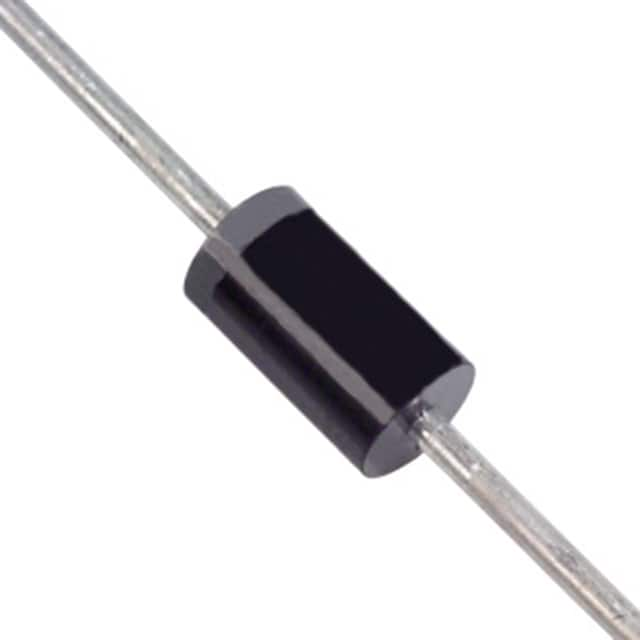Xem thông số kỹ thuật để biết chi tiết sản phẩm.

1N5408-B
Product Overview
The 1N5408-B is a rectifier diode belonging to the category of electronic components. It is commonly used in power supply circuits and voltage regulation applications due to its high current capability and low forward voltage drop. This diode is known for its robustness, making it suitable for various industrial and consumer electronic devices. The 1N5408-B is typically available in a through-hole package and is widely used in electronic circuits where reliable rectification is essential.
Basic Information
- Category: Electronic Components
- Use: Rectification and voltage regulation
- Characteristics: High current capability, low forward voltage drop
- Package: Through-hole
- Essence: Reliable rectification in electronic circuits
- Packaging/Quantity: Typically available in reels or tubes containing multiple units
Specifications
- Maximum Average Forward Current: 3A
- Peak Repetitive Reverse Voltage: 1000V
- Forward Voltage Drop: 1V at 3A
- Operating Temperature Range: -65°C to +175°C
Detailed Pin Configuration
The 1N5408-B rectifier diode has a standard axial lead configuration with two leads. The anode lead is typically longer than the cathode lead, allowing for easy identification and installation on a circuit board.
Functional Features
The 1N5408-B diode is designed to efficiently conduct current in one direction while blocking it in the opposite direction. This unidirectional flow of current enables the diode to perform rectification, converting alternating current (AC) into direct current (DC) in electronic circuits.
Advantages and Disadvantages
Advantages
- High current capability
- Low forward voltage drop
- Robust construction for reliability
Disadvantages
- Relatively large size compared to surface-mount diodes
- Higher reverse-recovery time compared to fast recovery diodes
Working Principles
When a positive voltage is applied to the anode of the 1N5408-B diode with respect to the cathode, it allows current to flow through the diode. Conversely, when a negative voltage is applied, the diode blocks the current flow. This behavior enables the diode to rectify AC voltage and provide a steady DC output.
Detailed Application Field Plans
The 1N5408-B diode finds extensive use in various electronic applications, including: - Power supply circuits - Voltage regulators - Battery chargers - Motor drive circuits - Inverters
Detailed and Complete Alternative Models
Several alternative models to the 1N5408-B diode include: - 1N4007 - 1N5819 - 1N5399 - FR107 - UF4007
In summary, the 1N5408-B rectifier diode is a reliable electronic component with high current capability and low forward voltage drop, making it well-suited for rectification and voltage regulation in a wide range of electronic circuits.
Word Count: 443
Liệt kê 10 câu hỏi và câu trả lời thường gặp liên quan đến ứng dụng 1N5408-B trong giải pháp kỹ thuật
What is the maximum voltage rating of 1N5408-B?
- The maximum voltage rating of 1N5408-B is 1000 volts.
What is the maximum current rating of 1N5408-B?
- The maximum current rating of 1N5408-B is 3 amperes.
What type of diode is 1N5408-B?
- 1N5408-B is a standard recovery rectifier diode.
What are the typical applications of 1N5408-B?
- Typical applications of 1N5408-B include power supplies, converters, and various other electronic circuits where high voltage and moderate current capabilities are required.
What is the forward voltage drop of 1N5408-B at its rated current?
- The forward voltage drop of 1N5408-B at its rated current is approximately 1 volt.
Is 1N5408-B suitable for high-frequency applications?
- No, 1N5408-B is not suitable for high-frequency applications due to its relatively slow recovery time.
Can 1N5408-B be used in reverse-biased mode?
- Yes, 1N5408-B can handle a limited amount of reverse voltage, but it's primarily designed for forward-biased operation.
What is the temperature range for 1N5408-B?
- The operating temperature range for 1N5408-B is typically -65°C to +175°C.
Does 1N5408-B require a heatsink in certain applications?
- Yes, in high-power or high-temperature applications, a heatsink may be necessary to dissipate heat effectively.
Is 1N5408-B RoHS compliant?
- Yes, 1N5408-B is RoHS compliant, meaning it meets the Restriction of Hazardous Substances directive for environmental safety.

